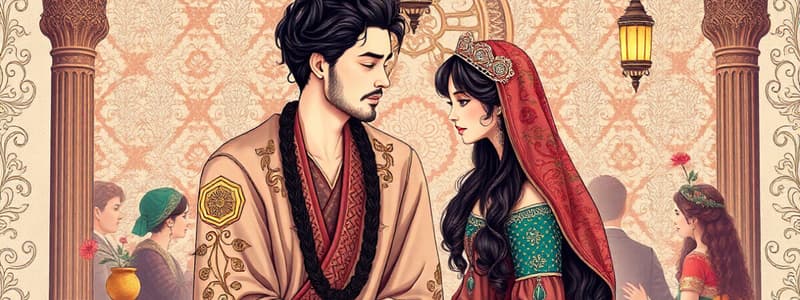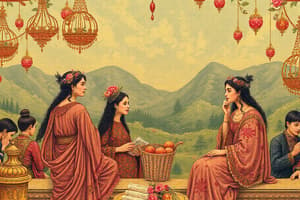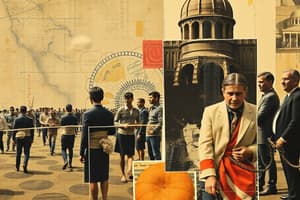Podcast
Questions and Answers
Which statement best describes the relationship between language and cultural characteristics?
Which statement best describes the relationship between language and cultural characteristics?
- Language is a determinant of how individuals interact with their surroundings. (correct)
- Language restricts cultural expressions to a fixed set of meanings.
- Language has no impact on how societies view their environment.
- Language functions solely as a tool for communication, without affecting beliefs.
What role do dominant value orientations play in a society?
What role do dominant value orientations play in a society?
- They create a hierarchy of preferences for alternative solutions. (correct)
- They eliminate all variations in cultural practices.
- They encourage societies to abandon traditional practices.
- They are always consistent and unchanging over time.
How do cultural norms develop in relation to survival?
How do cultural norms develop in relation to survival?
- They are contingent upon historical legacy rather than necessity.
- They arise despite environmental conditions.
- They emerge to enhance the survival and safety of group members. (correct)
- They are unrelated to the needs of group safety.
In what way do religious beliefs influence social identity?
In what way do religious beliefs influence social identity?
What is the significance of the ordering of preferences in changing societies?
What is the significance of the ordering of preferences in changing societies?
Which of the following is considered a feature of culture?
Which of the following is considered a feature of culture?
Which factor is integral to the spreading of cultural characteristics within a society?
Which factor is integral to the spreading of cultural characteristics within a society?
Which aspect of culture refers to the visible expressions such as language and clothing?
Which aspect of culture refers to the visible expressions such as language and clothing?
What do integrated coherent systems in culture primarily determine?
What do integrated coherent systems in culture primarily determine?
What is one major characteristic of culture?
What is one major characteristic of culture?
What component underlies the behavior and values of a culture?
What component underlies the behavior and values of a culture?
How does culture typically influence perceptions within a society?
How does culture typically influence perceptions within a society?
Why is understanding cultural variance essential for international managers?
Why is understanding cultural variance essential for international managers?
What do values in culture represent?
What do values in culture represent?
Which of the following statements about culture is true?
Which of the following statements about culture is true?
What is the deepest level of culture that influences members' beliefs and feelings undetected?
What is the deepest level of culture that influences members' beliefs and feelings undetected?
Which of the following best describes a characteristic of culture?
Which of the following best describes a characteristic of culture?
What is a primary way through which culture is transmitted?
What is a primary way through which culture is transmitted?
Which aspect is considered part of the essential core of culture?
Which aspect is considered part of the essential core of culture?
In the context of societal culture, which of the following debates is commonly discussed?
In the context of societal culture, which of the following debates is commonly discussed?
How does culture typically influence social groups?
How does culture typically influence social groups?
What is one of the notable features of culture?
What is one of the notable features of culture?
Which of the following accurately describes the relationship between culture and attitudes?
Which of the following accurately describes the relationship between culture and attitudes?
What role do symbols play in culture?
What role do symbols play in culture?
Which of the following statements about learned culture is false?
Which of the following statements about learned culture is false?
Flashcards
Cultural Norms
Cultural Norms
The beliefs and practices of a group of people that have developed over time to help them survive and thrive in their environment.
Language's Influence on Culture
Language's Influence on Culture
The way that language influences how people think and see the world.
Religion's Influence on Culture
Religion's Influence on Culture
The shared beliefs and values of a religion can influence a culture, shaping behaviors, attitudes, and social structures.
Social Identity
Social Identity
Signup and view all the flashcards
Ordering Preferences in Society
Ordering Preferences in Society
Signup and view all the flashcards
Value Orientations
Value Orientations
Signup and view all the flashcards
Solving Common Social Problems
Solving Common Social Problems
Signup and view all the flashcards
Cultural Integration
Cultural Integration
Signup and view all the flashcards
Cultural Context
Cultural Context
Signup and view all the flashcards
Cultural Artifacts
Cultural Artifacts
Signup and view all the flashcards
Espoused Values
Espoused Values
Signup and view all the flashcards
Basic Assumptions
Basic Assumptions
Signup and view all the flashcards
Cultural Transmission
Cultural Transmission
Signup and view all the flashcards
Factors of Cultural Variation
Factors of Cultural Variation
Signup and view all the flashcards
Cultural Adaptation
Cultural Adaptation
Signup and view all the flashcards
Understanding Cultural Dynamics
Understanding Cultural Dynamics
Signup and view all the flashcards
What is culture?
What is culture?
Signup and view all the flashcards
Is culture learned or inherited?
Is culture learned or inherited?
Signup and view all the flashcards
Is culture structured or random?
Is culture structured or random?
Signup and view all the flashcards
What are values in culture?
What are values in culture?
Signup and view all the flashcards
What are roles in culture?
What are roles in culture?
Signup and view all the flashcards
How does culture impact individuals?
How does culture impact individuals?
Signup and view all the flashcards
How does national culture affect international management?
How does national culture affect international management?
Signup and view all the flashcards
What is organizational culture?
What is organizational culture?
Signup and view all the flashcards
How do national and organizational cultures interact?
How do national and organizational cultures interact?
Signup and view all the flashcards
Study Notes
Session 3: Describing Culture
- Culture is shared, learned, systematic, and organized.
- Culture encompasses ways of doing, thinking, and being.
- National and organizational cultures interact.
Chapter 2: Goals
- Explain the concept of culture.
- Outline characteristics of societal culture.
- Illustrate sources of societal culture.
- Discuss debates surrounding the concept of culture.
- Express the relationship of culture to social groups.
Culture & Background
- Cultural background influences individual attitudes and behaviors.
- This particularly impacts international managers due to frequent interactions with people from diverse cultures.
- Culture broadly influences how international managers perceive their world, their actions, and expectations of them.
Culture Definition
- Patterned ways of thinking, feeling, and reacting.
- Acquired and transmitted primarily through symbols.
- Distinctive achievement of human groups.
- Includes embodiments in artifacts; core is traditional ideas and values.
- Affects individual psychology through shared values, tools, norms, habits, etc.
- Influences perceptions, interactions, social contacts, and related beliefs.
Characteristics of Culture
- Shared: Most members share similar mental programs.
- Learned: Acquired through social interaction and experience.
- Systematic and Organized: Not random, but structured.
Levels of Mental Programming
- Universal: Shared biological reactions (e.g., hunger).
- Culture: Shared intermediate-level patterns through experiences within a society.
- Personality: Unique individual characteristics.
Culture and Society
- Society: Enduring, cooperating group with interconnected relationships.
Studying That Suits You
Use AI to generate personalized quizzes and flashcards to suit your learning preferences.




